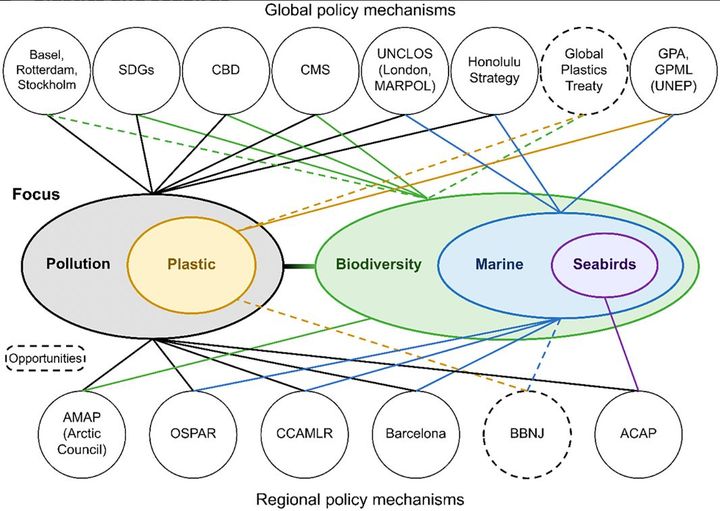
Plastic pieces form a Laysan Albatross Phoebastria immutabilis, a featured species for this year’s World Albatross Day.
Artwork by Jennifer Urmston using fragments collected on the windward shores of the Hawaiian island of Oahu, courtesy of David Hyrenbach
NOTE: This ACAP Latest News post kicks off seven days of "WADWEEK2023", marking World Albatross Day on 19 June and its theme of "Plastic Pollution".
Bonnie Hamilton (Department of Ecology and Evolutionary Biology, University of Toronto, Canada) and colleagues have published a review in Cambridge Prisms: Plastics that considers opportunities for monitoring plastic pollution using seabirds and multilateral agreements (one of which is ACAP).
The paper’s abstract follows:
“Seabirds have been the messengers of marine plastics pollution since the 1950s, not long after plastics began to be commercially manufactured. In the decades since, a number of multilateral agreements have emerged to address marine plastics pollution that have been informed by research and monitoring on plastic ingestion in seabirds. Seabirds continue to serve as effective monitors for plastics pollution in the oceans, and increasingly of the chemical contamination from the marine environment as plastic additives and chemicals can adsorb and accumulate in seabirds’ tissues. Plastics pollution has far-reaching ecological impacts, but the motivation for addressing the issue has escalated rapidly at the international level. Seabirds are also the most globally threatened group of birds and require concerted conservation actions to mitigate population declines from multiple pressures. However, most policy mechanisms focus on the monitoring and mitigation of anthropogenically induced stressors, using seabird data, and often fail to include mechanisms to conserve the messengers. In this review, we discuss how research on the impacts of plastics on seabirds is used to inform policy and highlight the competing interests of monitoring and conservation that emerge from this approach. Finally, we discuss policy opportunities to ensure seabirds can continue to be the indicators of ocean health and simultaneously achieve conservation goals.”

From the publication. Note that ACAP is an international agreement, not a regional body as shown here, although it is properly treated in the text
Reference:
Hamilton, B.M., Clark, B.L. & Borelle, S.B. 2023. Monitoring to conservation: the science–policy nexus of plastics and seabirds. Cambridge Prisms: Plastics, 1, e3, 1–8. doi.org/10.1017/plc.2023.2.
John Cooper, Emeritus Information Officer, Agreement on the Conservation of Albatrosses and Petrels, 13 June 2023

 English
English  Français
Français  Español
Español